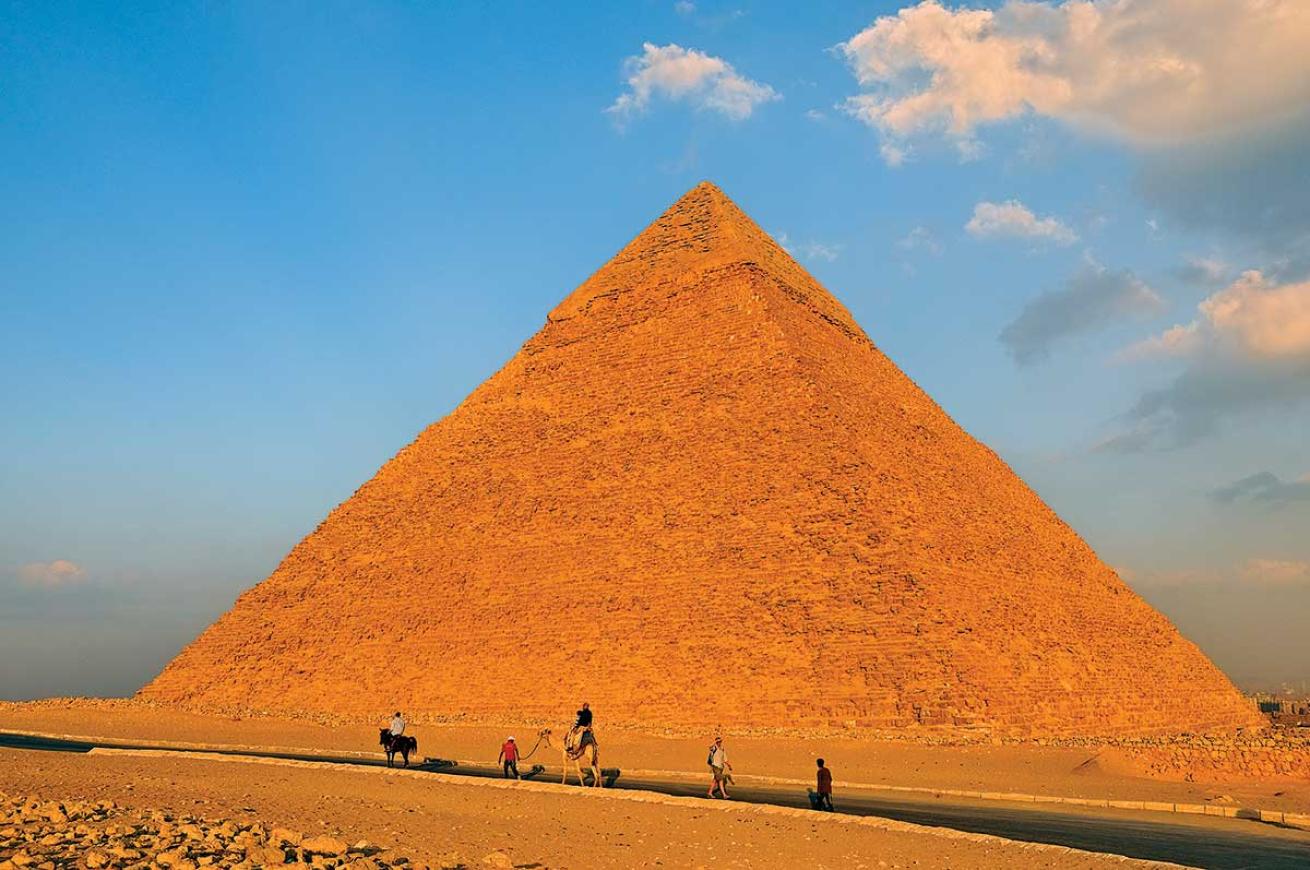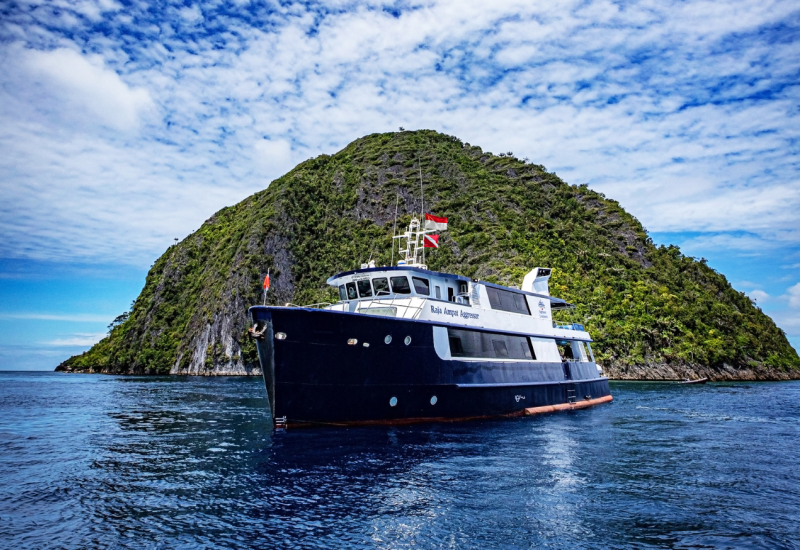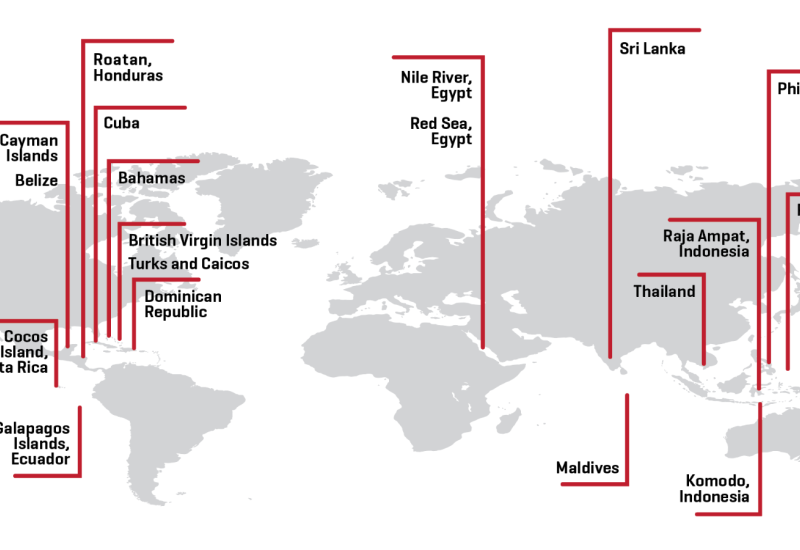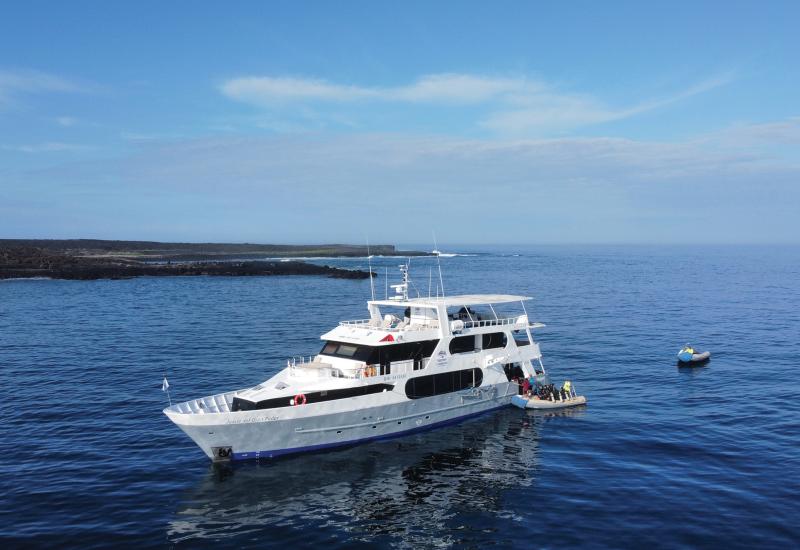Scuba Diving in Egypt Aboard the Red Sea Aggressor Liveaboard

Scott JohnsonDiving the Red Sea
Numidia is a diver’s treat to explore, from its precarious location to its lovely coating of soft corals.
I hammered away on my tank to attract the rest of the group’s attention, all the while marveling at the school of 19 hammerheads that was cruising in for a closer look at the invading bubble-blowers. My buddy, Brad, and I were the frontier party — hanging way out in the blue of Daedalus, looking for pelagics — while the others meandered along the sheer coral cliff. Our patience had paid off.
As I swam along, soaking up the magnificent view of these bizarre-looking sharks, with their distinctive meandering swimming motion, I was aware of a tank banger going of repeatedly near the reef. Turning to my right, I was astounded to see a 14-foot manta ray gliding toward me. I quickly snapped of a series of photographs as it breezed past me and turned, heading back out into the deep directly over my head. Watching the ray disappear, I caught Brad’s eye, and we celebrated with much fist-pumping. This is what everyone on board had come to the Red Sea for; this is what Daedalus is all about.

Scott JohnsonManta Magic
A manta ray flies underwater in the Red Sea.
BACK IN THE RED
The Aggressor Fleet has returned to the Red Sea, utilizing the tried-and-tested Suzanna 1 as its liveaboard. Red Sea Aggressor — it is also named Suzanna 1 for a variety of reasons — is a modern, well-appointed yacht, initially launched in 2004. On the itinerary I joined, apart from a lone South African and a British couple, all the divers were from the U.S. or Canada. This is great news for Egypt in today’s climate — North Americans know and trust the Aggressor brand. My dive buddy, Brad Gehrt, had been on several Aggressor and Dancer Fleet vessels, and that helped with his decision to try out Red Sea Aggressor for a week.
Red Sea Aggressor runs two itineraries back to back — north to Brothers, Daedalus and Elphinstone, beloved by Red Sea aficionados; and south to St. John’s/Fury Shoals — so several of the guests had been on the yacht the week before or were staying on after our trip. It’s a smart marketing idea that’s obviously working — if you’ve traveled this far to get here, why not stay for two weeks? Aggressor also does occasional 10-day specials that take in the best bits of both itineraries.
The 120-foot yacht has been outfitted to the highest standards and offers a comfortable base from which to explore the Red Sea. The salon is sumptuously furnished, and the sun decks have plenty of room for everyone, even on a full charter. Aggressor’s rigid inflatable boats are equipped with boarding ladders to make getting back in easier, and they’re larger than the average Red Sea Zodiacs, so even with 10 divers, it’s not too much of a squeeze.

Scott JohnsonSharks on Sharks on Sharks
An oceanic whitetip shark and its pilotfish entourage on Daedalus Reef in the Red Sea.
THE BROTHERS
The Brother Islands — also known as El Akhawein — are two pinnacles that protrude from the Red Sea some 60 miles offshore. There’s nothing else around besides these two barren outcrops that lie about a mile apart, magnets for marine life of all shapes and sizes.
Big Brother — the larger of the two, as the name suggests — is roughly cigar-shaped and approximately 2,500 feet long. It is topped by a British lighthouse, built in 1883, that is manned by military personnel who will sell you an “I Dived the Brothers” T-shirt.
On the north point lies the wreck of the Numidia, one of the most stunning wreck dives in the world. This huge cargo ship ran aground in 1901 and sank down the reef, becoming stuck at an impossibly vertical angle on the sheer wall. The bow has been smashed by constant wave action — the top 32 to 40 feet is broken wreckage, but beyond that the ship is remarkably intact down to the props at 280 feet.

Scott JohnsonCoral Beauty
A mob of orange anthias surround a diver underwater in the Red Sea.
Swept by sometimes strong currents, the Numidia is absolutely smothered in soft-coral growth that drapes over the superstructure, railings and masts. Reef fish swarm over the wreck, and gray reef sharks can be seen circling in the blue, along with the odd barracuda, trevally and tuna. The immense size of the wreck, plus its bizarre orientation, make it a dive not to be missed. Around the west side of Big Brother lies the wreck of the Aida. This Egyptian transport vessel was bringing supplies to the lighthouse in 1957 when it ran aground and broke in half — the bow was obliterated on the shallow reef; the stern sank into deeper water and lodged upright between 115 and 215 feet. You don’t get long on Aida because of the depth, but it’s covered in soft corals and makes for a dramatic view, disappearing into the deep.
Small Brother lies around a mile away, a circular island surrounded by sheer walls and deep plateaus. Currents sweep onto the north point, bringing nutrient-rich waters, which means the soft-coral growth is phenomenal. And you get sharks. Gray reefs are the most regular visitors, but hammerheads and threshers put in the odd appearance — we saw a couple of hammers, and the other RIB encountered a thresher and a manta ray. The sheer weight of life on Small Brother makes it a smorgasbord of rich, vibrant colors as all the reef fish flutter in and out of sponges, coral heads and reef outcroppings.

Scott JohnsonDiving from the Red Sea Aggressor
The Red Sea Aggressor allows divers to explore Egypt's ancient allure — below the waves.
DAEDALUS
My past three trips to Daedalus — Abu Kizan in Arabic — had been damp squibs, delivering nothing more exciting than the odd barracuda or trevally. This time around, it totally overshadowed its Big and Small Brothers.
After hearing reports of multiple hammerhead sightings during the previous few weeks, I was quietly harboring hopes for this large, circular reef. I needn’t have worried. The first two dives delivered lone and buddy-team hammerheads doing the odd flyby. But it was on the third dive when it all kicked of: a frenetic 10 minutes of glorious shoaling scalloped hammerhead action, which was topped of by a manta ray’s acrobatic display.
Inevitably, the second day at Daedalus couldn’t hold a candle to our manic first experience. We found the odd hammer, and another manta ray in a brief encounter, but otherwise, everyone was happy to enjoy the bizarrely tranquil conditions and absorb the views along the dramatic sheer walls.

Scott JohnsonAncient History and Mystery
Egypt's ancient allure is both topside and below the surface of the Red Sea.
ELPHINSTONE
Moving north to Elphinstone, we were greeted by less than ideal weather conditions. We attempted to moor on the northern plateau, but waves soon snapped a line, and our captain wisely motored to the south plateau to join the other liveaboards already there.
A strong current was running from west to east, but a few of us punched through it and hung at 100 feet, scanning the blue for any “men in gray suits.” Just as we were about to give up, we caught sight of two large dolphins, and then another four or five swept overhead and around us. The mammals put on a bit of a show, effortlessly darting here and there on the current-ripped plateau before heading of into the blue.
We drifted with the current down the east wall, keeping an eye on the blue for any pelagics that might show up. Alas, it was not to be, and conditions on the surface had deteriorated, so the cruise director called it quits.
All in all, it’s great to see Aggressor back in the Red Sea, and judging by this trip, a rosy future is guaranteed for this high-end liveaboard. As for me, I can’t wait to dive the southern itinerary.

Scott JohnsonAncient History and Mystery
Egypt's ancient allure is both topside and below the surface of the Red Sea.
FIVE REASONS TO CHOOSE RED SEA AGGRESSOR
1. Get Wrecked I defy any diver not to be blown away by the vertical wrecks of Numidia and Aida.
2. Sharks and More Sharks These offshore marine parks are famous for their shark encounters, including gray reef, hammerhead, oceanic whitetip, thresher, and even the occasional tiger and whale sharks.
3. Catch My Drift Due to their location in the middle of the Red Sea, the Brothers and Daedalus can sometimes be swept by extremely strong currents — get ready to put on your best Superman pose as you fly along the sheer walls.
4. Remoteness For most of the itinerary you will not have any cellphone signal; after all, you’re here to get away from life’s hustle and bustle. (Yes, there is a satellite phone available if you must.)
5. Culture Vulture You can’t travel all the way to Egypt and not venture out to some of the ancient attractions. The Aggressor team can assist with visits to the Pyramids and Valley of the Kings, and cruises down the River Nile.
NEED TO KNOW
When To GoYear-round, but the better conditions tend to be in summer. Winter can deliver more shark action.
Dive Conditions Summer water temps average 84 degrees, so a 3 mm shorty or wetsuit is sufficient. In winter, temps can drop to 73 degrees, so a 7 mm suit (or drysuit) is a better option. Entries and exits from the RIBs can be rough; being comfortable with back rolls and negative descents is a plus.
Logistics Red Sea Aggressor departs from Port Ghalib, near Marsa Alam. There are numerous fights into Hurghada, about a four-hour minibus transfer from the marina, or you can get on a scheduled fight into Marsa Alam International Airport.
Operator Red Sea Aggressor (aggressor.com) can take 20 passengers and 12 crew.
Price Tag Deluxe staterooms start from $1,899.










